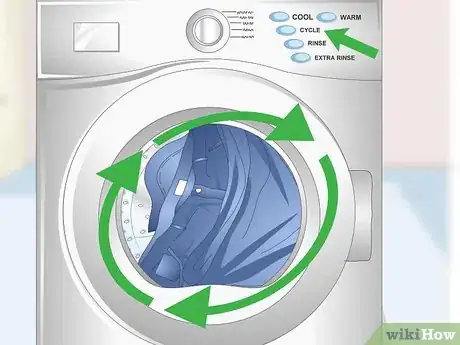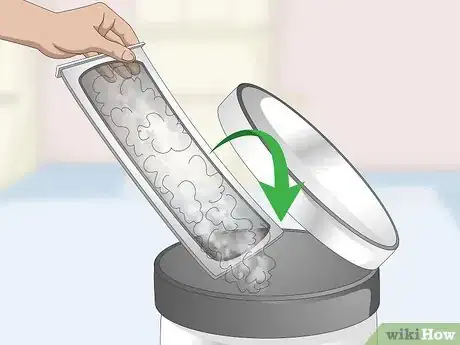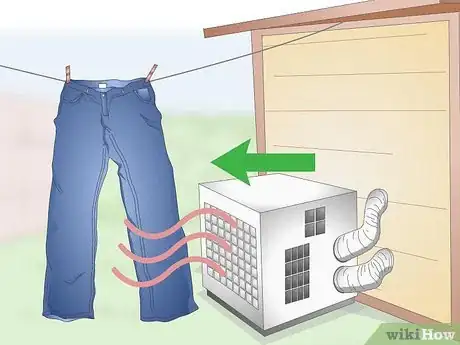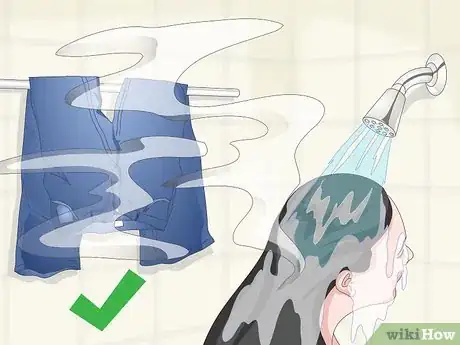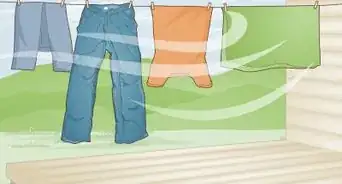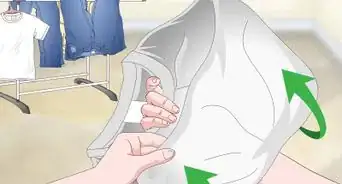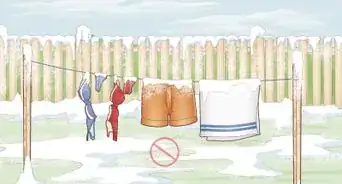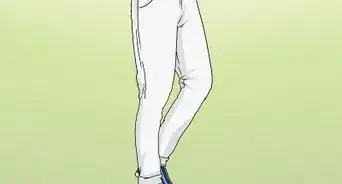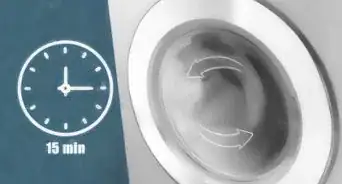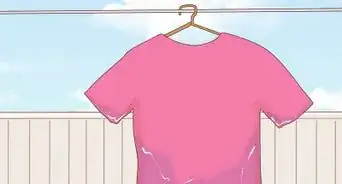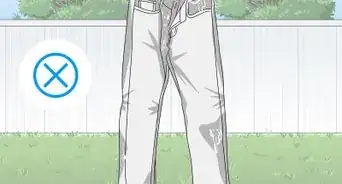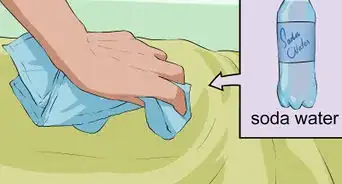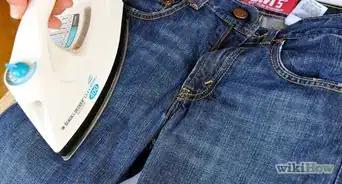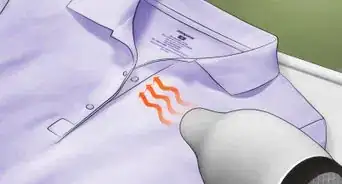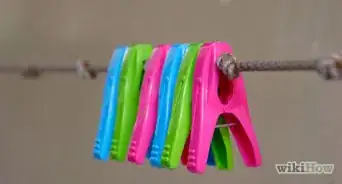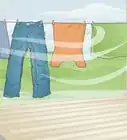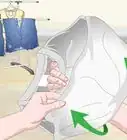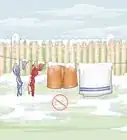This article was co-authored by wikiHow Staff. Our trained team of editors and researchers validate articles for accuracy and comprehensiveness. wikiHow's Content Management Team carefully monitors the work from our editorial staff to ensure that each article is backed by trusted research and meets our high quality standards.
There are 13 references cited in this article, which can be found at the bottom of the page.
This article has been viewed 57,384 times.
Learn more...
There’s nothing more frustrating than pulling on a pair of pants fresh out of the dryer and realizing they’re still damp. If you need your best business-casual slacks or lucky pair of jeans pronto and time is of the essence, there are a few tricks you can use to speed things along. First, remove all excess water left in the pants by pressing them with a towel or running them through the washing machine’s spin cycle. Then, you can tumble them dry on a high heat setting, draw on an external heat source, or increase the airflow in the room to take them from wet to wearable in record time.
Steps
Drying Your Pants in a Tumble Dryer
-
1Take advantage of the spin cycle. If you’re used to removing your wet clothes as soon as they’ve finished washing, try holding off until the spin cycle is complete. The rapid movement of the drum will whisk excess moisture out of the pants, getting them that much closer to dry by the time they go into the dryer. Think of it as giving yourself a head start.[1]
- The spin cycle only takes an average of 5-10 minutes on most washing machines, but has the potential to save you a considerable amount of drying time, depending on the material of the item.
-
2Throw a dry towel in the dryer. Towels are designed to be absorbent, which means they’ll soak up water every time they collide with your wet trousers. The moisture will be distributed between the towel and pants, and the pants will dry faster as a result—you can worry about the towel later.[2]
- Make sure the towel you use is made from a moisture-wicking material like cotton.
- Be sure to remove the towel after about 15 minutes. After that, it will just start contributing moisture to the rest of the load.[3]
Advertisement -
3Use a timed dry with a high heat setting. Instead of using one of the dryer’s presets, select a specific time frame and make sure the heat level is as high as it can go. When the timer goes off, check the pants. If they still feel damp, put them back in for 5 minutes at a time until they feel dry to the touch. You might be surprised by how little time it actually takes to get your clothes dry.[4]
- Most people are used to loading the dryer, twisting the dial to “normal,” and letting it run until it’s finished. If you’re in a hurry, however, this can really eat into your time, and may not even be necessary.
- Drying natural materials like cotton on high heat regularly may cause shrinking or damage the fabric.[5]
-
4Clear the lint trap. Remove the lint trap from the top of the dryer and tap it over a trash can to loosen the dust and fibers that have accumulated on it, then slide it back into place. Keeping the lint trap clean ensures that your dryer is performing at peak efficiency, and could shave an extra few minutes off your total drying time.[6]
- A pristine lint trap channels heat and air much more efficiently than one that’s blocked up with debris.[7]
- Get in the habit of emptying the lint trap after every 2-3 loads of laundry you run through the dryer.
- It's also a good idea to make sure the exhaust duct that carries hot air out of the dryer isn't blocked up. Over time, dust, lint, and cobwebs can accumulate inside, reducing air flow and creating a potential fire hazard.
Air Drying Your Pants
-
1Roll the wet pants up in a towel. Even if you don’t have the benefit of a tumble dryer, a trusty towel can still come in handy for ensuring that your clothes start out as dry as possible. Lay out a clean, dry towel and place the pants unfolded on top. Then, roll the towel up from one end with the pants inside. Squeeze the bundle gently with both hands to coax out any remaining water.[8]
- Rolling your damp pants in a towel can actually help work out wrinkles, which can be useful for more formal styles.
- Sitting on the towel for a couple minutes will create even more pressure.
-
2Separate the pants from other clothes. A heap of overlapping items will just smother one another and prevent moisture from escaping. When you need your good leggings ASAP, make sure they have plenty of space. Reserve them their own rungs if you’re using a drying rack, or set them aside on a different surface where they can air out undisturbed. Ideally, the pants you’re drying shouldn’t even be touching another article of clothing.[9]
- Remember—heat rises. The higher up you stash your britches, therefore, the more favorable circulation air and temperature will be.
- Leave a few inches of space between each item on an outdoor clothesline.
-
3Increase the airflow around the item. To speed up the air-drying process even more, hang the pants up at their full length on a makeshift clothesline, or stretch them out over multiple rungs on a drying rack. This will create more surface area for air to circulate over. Make sure the pants aren’t wadded or bunched, as the folds will keep moisture trapped between the layers of the fabric.[10]
- If you’re using a flat drying surface, turn the pants over every 10 minutes to let the opposite side get a little exposure.
- When drying clothing outside, look for breezy, open areas where plenty of wind and sunlight will be able to get to the wet garment.
- Plug in a portable fan and position it in front of your drying dungarees for a little assistance.[11]
-
4Set up your drying surface near a heat source. If possible, scoot your drying rack up next to a radiator or space heater. You could also try running the heat in your home while the pants are drying, or leaving them in a warmer area like the kitchen while you’re making dinner.[12]
- Don’t set your damp clothing directly on the heat source or situate them too close, or else they could become a fire hazard.[13]
-
5Accelerate drying using the heat from the shower. Assuming you’re in a hurry to get ready to go somewhere, you can kill two birds with one stone by bringing the pants into the bathroom with you while you scrub up. Hang them on the towel rack or drape them over the edge of the sink, and make sure the door is closed. The elevated temperatures will quicken evaporation, and will even steam press natural fabrics, to boot.[14]
- Be sure to place the pants far enough away from the shower itself to keep them from getting any wetter.
- For best results, hang the pants up at their full length. Together, gravity and steam will help smooth out wrinkles.[15]
Utilizing Other Drying Tricks
-
1Spot-dry the pants with a hair dryer. Sometimes, wetness will linger stubbornly in thicker parts of the fabric even though the majority is already dry. Blast problem areas like waistbands, pockets, and hems on high heat to give them some individual attention. This is much more expedient than focusing on the whole garment when there’s just a couple spots holding you up.[16]
- Wave the heat stream back and forth over each area slowly until it’s dry. Jumping back and forth between different sections will just make them take longer to dry.
- Keep the nozzle about a foot away from the pants to avoid burning or overdrying the fabric (which can cause it to stiffen).[17]
-
2Put them on. If you’ve got somewhere to be and you’re running out of options, a good last resort solution is to go ahead and get dressed, even if the pants are still slightly damp. As you move around, your body heat will radiate through the fabric and finish what you started by tumble or air drying. By the time you get where you’re going, you’ll have forgotten what you were so worried about in the first place.[18]
- The pants should feel just barely clammy to the touch before you climb into them.
- You’ll get the best results when the weather outside is warm and breezy. Wearing wet clothing in the wintertime may not be such a great idea.
-
3Dry the pants over an open fire. Should you ever find yourself stranded in the wilderness with a soggy bottom, your campfire can be good for more than just providing heat. Suspend a clothesline a few feet above the flames, or improvise one using tree branches or a similar object. The heat from the blaze will do away with lingering moisture in an hour or so, especially when coupled with a warm breeze.[19]
- Reposition the pants every few minutes to make sure they come out equally dry all over.
- Be careful not to let the wet fabric come into contact with the fire itself—this is a good way to go home with no pants.
- It only takes a moderate amount of heat to effectively dry wet clothes over a fire. If there’s steam rising from the pants, it means they’re getting too hot.[20]
Community Q&A
-
QuestionWhat if I spilled chocolate milk on my pants while I'm still at school?
 Community AnswerIf that happens, then you must go to the bathroom and clean what you can with water and soap. Use something to hide the stain, or just laugh about your mistake.
Community AnswerIf that happens, then you must go to the bathroom and clean what you can with water and soap. Use something to hide the stain, or just laugh about your mistake.
Warnings
- Pay attention to the way your pants look and feel while you're drying them. A starchy texture or strange, acrid smell could be an indication that excess heat is damaging the damp fabric.⧼thumbs_response⧽
Things You'll Need
- Clothes dryer
- Drying rack or clothes horse
- Clothesline (optional)
- Hair dryer
- Radiator or space heater
- Portable fan
- Clean, dry towel
- Pants
References
- ↑ https://removeandreplace.com/2013/07/19/5-easy-ways-on-how-to-dry-your-clothes-faster-in-your-dryer-helpful-tips/
- ↑ http://www.apartmenttherapy.com/timesaving-tip-how-to-quickly-dry-a-load-of-laundry-206749
- ↑ https://lifehacker.com/the-real-way-to-your-clothes-dry-faster-with-a-towel-499919864
- ↑ https://removeandreplace.com/2013/07/19/5-easy-ways-on-how-to-dry-your-clothes-faster-in-your-dryer-helpful-tips/
- ↑ https://www.reviewed.com/laundry/features/how-dryers-destroy-your-clothes
- ↑ http://backpackingmastery.com/skills/how-to-dry-clothes-fast.html
- ↑ http://www.homestructions.com/general/clean-lint-trap/
- ↑ https://home.onehowto.com/article/tricks-to-dry-clothes-faster-without-a-dryer-1985.html
- ↑ https://laundrapp.com/blog/6-laundry-hacks-for-drying-your-clothes/
- ↑ https://www.ovoenergy.com/blog/lifestyle/how-to-dry-your-clothes-in-a-flash-without-a-tumble-dryer.html
- ↑ http://www.bhg.com/homekeeping/laundry-linens/clothes/dry-clothes/
- ↑ https://home.onehowto.com/article/tricks-to-dry-clothes-faster-without-a-dryer-1985.html
- ↑ https://laundrapp.com/blog/6-laundry-hacks-for-drying-your-clothes/
- ↑ https://home.onehowto.com/article/tricks-to-dry-clothes-faster-without-a-dryer-1985.html
- ↑ http://www.thefashionspot.com/life/178349-how-to-shower-steam-your-clothes-and-other-broke-girl-fashion-fixes/
- ↑ https://www.ovoenergy.com/blog/lifestyle/how-to-dry-your-clothes-in-a-flash-without-a-tumble-dryer.html
- ↑ https://home.onehowto.com/article/how-to-dry-clothes-with-a-hair-dryer-12345.html
- ↑ http://survival-mastery.com/skills/bushcraft/how-to-dry-clothes-fast.html
- ↑ http://backpackingmastery.com/skills/how-to-dry-clothes-fast.html
- ↑ http://survival-mastery.com/skills/bushcraft/how-to-dry-clothes-fast.html
